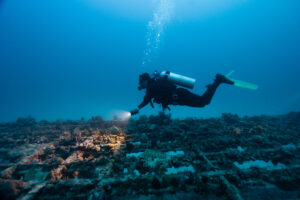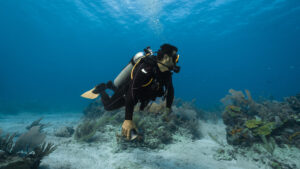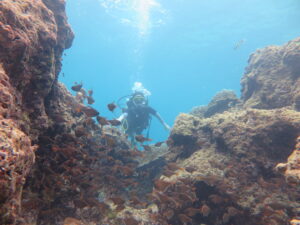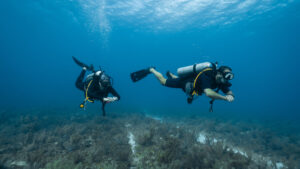What is a Blue Hole?
A blue hole is a captivating underwater geological feature that intrigues scientists, divers, and marine enthusiasts alike. These large marine caverns or sinkholes are open to the surface and often grant access to submerged cave passages, providing unique environments for marine life to thrive. Blue holes are found in various parts of the world, with notable examples in Belize, the Bahamas, Guam, Australia’s Great Barrier Reef, and Egypt’s Red Sea. This entry delves into the formation and characteristics of blue holes, their importance to marine ecosystems, and the famous blue holes around the world.
Formation and Characteristics
Blue holes are formed through the dissolution of carbonate rocks, primarily limestone or dolomite, in a process known as karstification. Over time, the dissolution of these rocks by rainwater and groundwater creates cavities that may eventually collapse, resulting in the formation of sinkholes. In coastal regions, these sinkholes may become submerged and develop into blue holes.
The unique blue color of these underwater sinkholes is attributed to the depth and water clarity. As sunlight penetrates the water, the longer-wavelength colors (red, orange, yellow, and green) are absorbed, leaving the shorter-wavelength colors (blue and violet) to scatter and dominate. The deeper the hole, the more intense the blue hue appears.
Blue holes vary in size and depth, ranging from tens of meters wide to several hundred meters deep. They are characterized by a shallow, often circular, opening at the surface, which leads to a vertical shaft that may extend to considerable depths. The shaft may contain horizontal tunnels and chambers that branch off into submerged cave systems.
Ecological Importance
Blue holes are ecologically significant, as they provide shelter and breeding grounds for a diverse array of marine species. The unique combination of depth, limited water circulation, and reduced light penetration creates distinct microhabitats within blue holes, supporting both benthic and pelagic organisms. This includes a wide range of fish, corals, sponges, and crustaceans. Blue holes also serve as an oasis for migratory species, offering them a temporary refuge during their long journeys.
Moreover, blue holes are valuable sites for scientific research. The undisturbed sediments found in these environments can offer insights into past climate conditions and geological events, while the study of their unique ecosystems can contribute to a better understanding of marine biodiversity and evolution.
Famous Blue Holes Around the World
- The Great Blue Hole (Belize): Located off the coast of Belize, the Great Blue Hole is the most famous and well-studied blue hole. This UNESCO World Heritage Site measures over 300 meters in diameter and reaches depths of approximately 125 meters. The Great Blue Hole is a popular destination for scuba divers seeking encounters with various shark species, including Caribbean reef sharks, hammerheads, and bull sharks.
- Dean’s Blue Hole (Bahamas): Found on Long Island in the Bahamas, Dean’s Blue Hole is the world’s deepest known blue hole, with a depth of 202 meters. It attracts free-divers from around the world, who attempt to break depth records in this challenging and awe-inspiring environment.
- Blue Hole of Guam (Guam): Located near the Apra Harbor, the Blue Hole of Guam is a popular dive site that plunges to a depth of approximately 90 meters. Divers can explore the vertical shaft and its adjacent coral reef, which is home to various fish species, eels, and sea turtles.
- Lady Musgrave Island Blue Hole (Australia): Situated within the Great Barrier Reef Marine Park, the Lady Musgrave Island Blue Hole is surrounded by vibrant coral reefs teeming with marine life. The blue hole itself is approximately 20 meters deep and attracts divers seeking to explore its underwater caves and tunnels.
- Dahab Blue Hole (Egypt): Located in the Red Sea near Dahab, Egypt, this blue hole is renowned for its beauty and the challenge it presents to divers. The Dahab Blue Hole is approximately 130 meters deep and features an archway known as “The Arch” at a depth of 56 meters, connecting the hole to the open sea. The site is notorious for its strong currents and has claimed the lives of several divers, earning it the nickname “Diver’s Cemetery.”
Conservation and Responsible Tourism
The fragile ecosystems within blue holes are susceptible to human-induced damage, including pollution, overfishing, and habitat destruction. To ensure the preservation of these unique environments, several blue holes have been designated as protected areas, subject to specific conservation measures and regulations. Divers visiting these sites are encouraged to follow guidelines set forth by local authorities and dive operators, such as maintaining neutral buoyancy, minimizing contact with the environment, and adhering to safe diving practices.
In recent years, there has been a growing interest in blue holes as dive tourism destinations. While responsible tourism can contribute to local economies and raise awareness about marine conservation, it is crucial to balance the benefits with the potential impact on these fragile ecosystems. As such, many blue hole locations have implemented sustainable tourism practices, such as limiting visitor numbers, providing environmental education programs, and supporting local conservation initiatives.
Key Takeaways
Blue holes are fascinating underwater geological features that captivate both scientists and divers alike. The unique conditions within these marine caverns support diverse ecosystems, offering valuable insights into marine biodiversity and geological history. By promoting responsible tourism and implementing conservation measures, it is possible to preserve these natural wonders for future generations to appreciate and explore. As our understanding of blue holes continues to grow, so too will our appreciation for their ecological significance and the need to protect these unique environments.








